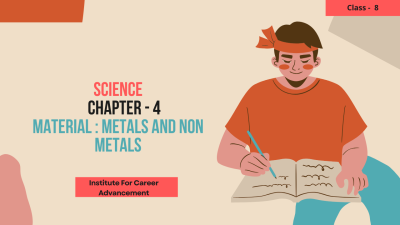| Outcomes |
- Here are the typical course outcomes: Knowledge and Understanding Identification and Classification: Students will be able to identify metals and non-metals based on their physical properties such as conductivity, malleability, and appearance. Physical Properties: Students will understand the specific physical properties of metals (conductivity, malleability, ductility, etc.) and non-metals (brittleness, poor conductivity, etc.) and how these properties influence their uses. Chemical Properties: Students will grasp the basic chemical properties of metals (reactivity, corrosion) and non-metals (reactivity, formation of oxides) and their implications in chemical reactions. Extraction and Processing: Students will learn about the methods used to extract metals from their ores (smelting, electrolysis) and how these processes contribute to their availability and purity. Application and Skills Practical Applications: Students will be able to explain and give examples of how metals and non-metals are used in everyday life, industry, and technology (e.g., construction, electrical wiring, chemical production). Experimental Skills: Through practical experiments, students will develop skills in observing and measuring physical and chemical properties of metals and non-metals, and interpreting experimental results. Critical Thinking and Analysis Comparison and Contrast: Students will analyze and compare the properties of metals and non-metals, highlighting similarities and differences that dictate their uses and behavior in different contexts. Problem-solving: Students will apply their understanding of metals and non-metals to solve problems related to their extraction, use, and environmental impact, considering sustainable practices where applicable. Environmental and Ethical Considerations Environmental Impact: Students will recognize the environmental consequences of metal extraction and use, and evaluate strategies to minimize these impacts (e.g., recycling, responsible mining practices). Ethical Awareness: Students will discuss ethical considerations related to the use of metals and non-metals, including issues of resource distribution, social responsibility in mining communities, and sustainable consumption. Communication and Collaboration Communication Skills: Students will effectively communicate their understanding of metals and non-metals through written explanations, diagrams, and presentations. Collaborative Learning: Students will engage in group discussions and collaborative projects to explore real-world applications and implications of metals and non-metals.
- এখানে সাধারণ কোর্সের ফলাফল রয়েছে: জ্ঞান এবং বোঝার সনাক্তকরণ এবং শ্রেণীবিভাগ: শিক্ষার্থীরা তাদের শারীরিক বৈশিষ্ট্য যেমন পরিবাহিতা, নমনীয়তা এবং চেহারার উপর ভিত্তি করে ধাতু এবং অধাতু সনাক্ত করতে সক্ষম হবে। ভৌত বৈশিষ্ট্য: শিক্ষার্থীরা ধাতুগুলির নির্দিষ্ট ভৌত বৈশিষ্ট্য (পরিবাহিতা, নমনীয়তা, নমনীয়তা, ইত্যাদি) এবং অ-ধাতু (ভঙ্গুরতা, দুর্বল পরিবাহিতা, ইত্যাদি) এবং কীভাবে এই বৈশিষ্ট্যগুলি তাদের ব্যবহারকে প্রভাবিত করে তা বুঝতে পারবে। রাসায়নিক বৈশিষ্ট্য: শিক্ষার্থীরা ধাতুর মৌলিক রাসায়নিক বৈশিষ্ট্য (প্রতিক্রিয়াশীলতা, ক্ষয়) এবং অধাতু (প্রতিক্রিয়াশীলতা, অক্সাইডের গঠন) এবং রাসায়নিক বিক্রিয়ায় তাদের প্রভাব বুঝতে পারবে। নিষ্কাশন এবং প্রক্রিয়াকরণ: শিক্ষার্থীরা তাদের আকরিক থেকে ধাতু নিষ্কাশনের জন্য ব্যবহৃত পদ্ধতিগুলি সম্পর্কে শিখবে (গন্ধ, ইলেক্ট্রোলাইসিস) এবং কীভাবে এই প্রক্রিয়াগুলি তাদের প্রাপ্যতা এবং বিশুদ্ধতায় অবদান রাখে। আবেদন এবং দক্ষতা ব্যবহারিক প্রয়োগ: শিক্ষার্থীরা দৈনন্দিন জীবনে, শিল্প এবং প্রযুক্তিতে (যেমন, নির্মাণ, বৈদ্যুতিক তারের, রাসায়নিক উত্পাদন) কীভাবে ধাতু এবং অধাতু ব্যবহার করা হয় তার উদাহরণ ব্যাখ্যা করতে এবং দিতে সক্ষম হবে। পরীক্ষামূলক দক্ষতা: ব্যবহারিক পরীক্ষা-নিরীক্ষার মাধ্যমে শিক্ষার্থীরা ধাতু এবং অধাতুর ভৌত ও রাসায়নিক বৈশিষ্ট্য পর্যবেক্ষণ ও পরিমাপ করতে এবং পরীক্ষামূলক ফলাফল ব্যাখ্যা করার দক্ষতা বিকাশ করবে। সমালোচনামূলক চিন্তাভাবনা এবং বিশ্লেষণ তুলনা এবং বৈসাদৃশ্য: শিক্ষার্থীরা ধাতু এবং অধাতুর বৈশিষ্ট্য বিশ্লেষণ এবং তুলনা করবে, মিল এবং পার্থক্যগুলিকে হাইলাইট করবে যা বিভিন্ন প্রসঙ্গে তাদের ব্যবহার এবং আচরণ নির্দেশ করে। সমস্যা-সমাধান: শিক্ষার্থীরা তাদের নিষ্কাশন, ব্যবহার এবং পরিবেশগত প্রভাব সম্পর্কিত সমস্যাগুলি সমাধান করতে ধাতু এবং অধাতু সম্পর্কে তাদের বোঝাপড়া প্রয়োগ করবে, যেখানে প্রযোজ্য টেকসই অনুশীলনগুলি বিবেচনা করে। পরিবেশগত এবং নৈতিক বিবেচনা পরিবেশগত প্রভাব: শিক্ষার্থীরা ধাতু নিষ্কাশন এবং ব্যবহারের পরিবেশগত পরিণতিগুলিকে চিনবে এবং এই প্রভাবগুলি (যেমন, পুনর্ব্যবহার, দায়িত্বশীল খনির অনুশীলন) কমানোর জন্য কৌশলগুলি মূল্যায়ন করবে। নৈতিক সচেতনতা: শিক্ষার্থীরা সম্পদ বন্টন, খনির সম্প্রদায়ের সামাজিক দায়িত্ব এবং টেকসই খরচ সহ ধাতু এবং অধাতুর ব্যবহার সম্পর্কিত নৈতিক বিবেচনার বিষয়ে আলোচনা করবে। যোগাযোগ এবং সহযোগিতা যোগাযোগ দক্ষতা: শিক্ষার্থীরা লিখিত ব্যাখ্যা, ডায়াগ্রাম এবং উপস্থাপনার মাধ্যমে ধাতু এবং অধাতু সম্পর্কে তাদের বোঝার বিষয়ে কার্যকরভাবে যোগাযোগ করবে। সহযোগিতামূলক শিক্ষা: শিক্ষার্থীরা ধাতু এবং অধাতুর বাস্তব-বিশ্বের অ্যাপ্লিকেশন এবং প্রভাবগুলি অন্বেষণ করতে গ্রুপ আলোচনা এবং সহযোগী প্রকল্পগুলিতে নিযুক্ত হবে।
|
|
|
| Requirements |
- Metals and non-metals are fundamental building blocks of chemistry and materials science. Studying them provides insights into the physical properties of elements and how these properties influence their behavior and applications in everyday life. Metals are crucial in construction, manufacturing, and technology due to their conductivity, strength, and durability. Non-metals play vital roles in areas like agriculture (fertilizers), medicine, and electronics. Understanding their properties helps in selecting the right materials for specific applications. Studying Metals and Non-metals at the Class 8 level is not just about learning scientific concepts but also about preparing students to be informed, responsible global citizens. It equips them with the knowledge and skills to understand and address real-world challenges related to resource management, environmental sustainability, technological advancement, and ethical considerations in material usage.
- ধাতু এবং অধাতু হল রসায়ন এবং পদার্থ বিজ্ঞানের মৌলিক বিল্ডিং ব্লক। এগুলি অধ্যয়ন করা উপাদানগুলির শারীরিক বৈশিষ্ট্যগুলির অন্তর্দৃষ্টি প্রদান করে এবং কীভাবে এই বৈশিষ্ট্যগুলি দৈনন্দিন জীবনে তাদের আচরণ এবং প্রয়োগগুলিকে প্রভাবিত করে। ধাতুগুলি তাদের পরিবাহিতা, শক্তি এবং স্থায়িত্বের কারণে নির্মাণ, উত্পাদন এবং প্রযুক্তিতে গুরুত্বপূর্ণ। অ-ধাতুগুলি কৃষি (সার), ওষুধ এবং ইলেকট্রনিক্সের মতো ক্ষেত্রে গুরুত্বপূর্ণ ভূমিকা পালন করে। তাদের বৈশিষ্ট্য বোঝা নির্দিষ্ট অ্যাপ্লিকেশনের জন্য সঠিক উপকরণ নির্বাচন করতে সাহায্য করে। ক্লাস 8 স্তরে ধাতু এবং অধাতু অধ্যয়ন শুধুমাত্র বৈজ্ঞানিক ধারণা শেখার জন্য নয় বরং শিক্ষার্থীদেরকে সচেতন, দায়িত্বশীল বিশ্ব নাগরিকদের জন্য প্রস্তুত করাও। এটি তাদের সম্পদ ব্যবস্থাপনা, পরিবেশগত স্থায়িত্ব, প্রযুক্তিগত অগ্রগতি এবং বস্তুগত ব্যবহারের ক্ষেত্রে নৈতিক বিবেচনার সাথে সম্পর্কিত বাস্তব-বিশ্বের চ্যালেঞ্জগুলি বুঝতে এবং মোকাবেলা করার জন্য জ্ঞান এবং দক্ষতা দিয়ে সজ্জিত করে।
|
|
|


 0
0 